In the series of paintings which he calls Tragicomedy, Alfredo Esquillo Jr. displays his more surrealist bent. For these works, he makes repeated use of an image he christens as the wheelchair-jeepney. A product of his imagination, he paints this as a jeepney’s dashboard without an engine. Instead, the large wheels of the wheelchair appear to mechanically power the hybrid vehicle. Through the years, Esqui has employed this in several of his pieces: on its own in Third World, pushed around in circles by several buffoons in Survivor, carrying a load of cartons in Lipat-Bahay. He uses the wheelchair-jeepney as a device to underscore the hobbled and disabled state we Pinoys find ourselves unable to shake off, the legacy of repeated missteps by our political leadership. Another conveyance that we see repeatedly in his tragicomedies is the double-faced jeepney, two jeepney dashboards facing opposite directions. Esqui has used this as a metaphor for the Philippines’ lack of progress. The state has two drivers pulling it in opposite directions.
As Esqui forays into kinetic sculpture with Bato Bato Sa Langit, his exhibit now on view at SLab, he takes these vehicles out of his canvases, and transforms them into almost life-sized, multi-dimensional, mixed media contraptions. Alab Ng Puso is a wheelchair-jeepney, painted fiery red. Kabilaan is a two-faced jeepney. While with Penitente, he assembles a wheelchair-pedicab that flagellates its driver as he pedals forward. Made primarily with chrome, each piece has several details seen only on closer inspection. Esqui’s self-portrait hides beneath Alab ng Puso’s grille. Lift up the hood and you see the vehicle’s heart. When Kabilaan moves to and fro, the two mini lechons atop each of its two hoods turn as they roast over fake flames.
Three large-scale painted works, which may be classified as new additions to his Archival series, hang on the gallery’s walls. For these, Esqui manipulates images from found historical photographs while retaining their sepia tones. He finishes these off with a fine layer of sawdust. B. I. Joe and Barangay Yosi , painted on canvas, make commentaries on the colonialization of indigeneous Filipinos via their smoking habits.
For the triptych Libing At Sakla, Esqui reverts to the use of another favorite ground, that of rubber. He adopts three slightly varying versions of a photograph that shows a group standing beside freshly-dug earth. Look closely at the crowd gathered around the grave, and notice that for each panel, the subjects on the extreme right
differ. The first panel uses the likeness of Zaldy Ampatuan (accused mastermind of the Maguindanao massacre) on one of the men donning a straw hat. For the middle panel, the face has changed to that of Emilio Aguinaldo. In the last panel, underneath two parasols, stand Ferdinand and Imelda Marcos. The piece speaks of grand betrayals, and for Esqui, this cast of characters made the ultimate betrayals to public trust. He also references Sakla, the Spanish tarot card game played during funeral wakes, to describe the panels (Haring Bastos, Haring Espada, Haring Oros). An assemblage of skeleton parts cast from resin, along with metal objects from the Sakla card symbols, fill the bottom portion of all three panels.
Fifteen years since Esqui first made his impact in the art scene via his ASEAN Art Awards Grand Prize, he has not let up. He continues to give us art culled from episodes in our history, our religious beliefs, our socio-political concerns. In other words, art that makes us think.
Bato Bato Sa Langit, Alfredo Esquillo Jr., runs from 9 June to 3 July at SLab, 2F YMC Bldg 2, 2320 Pasong Tamo Extension, Makati City. Phone (632)816-0044 or visit http://www.alfredoesquillo.com or visit http://www.slab.silverlensphoto.com
Thank you to Marya Salang of Tin-Aw Arts Management for the video of the opening night’s performance.

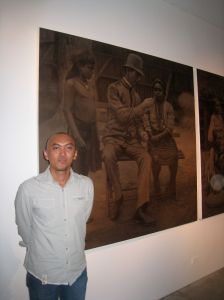
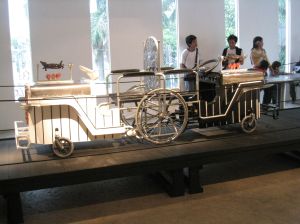
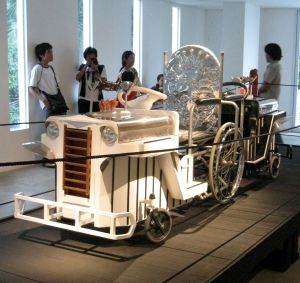
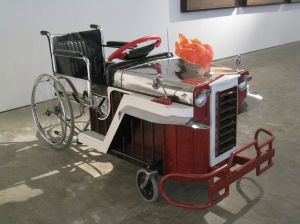

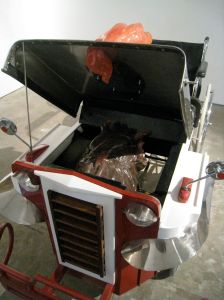
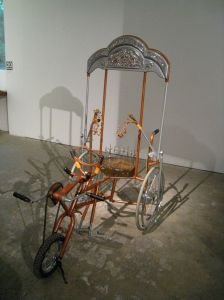


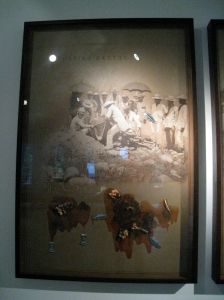
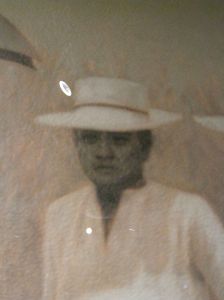
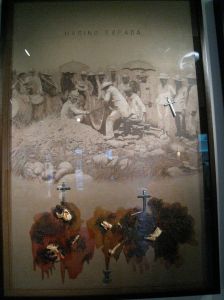
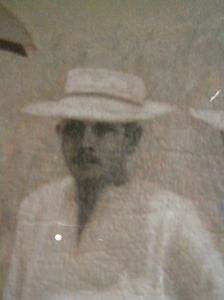
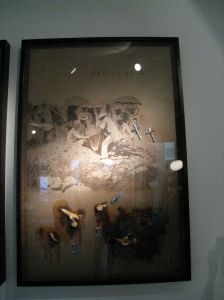
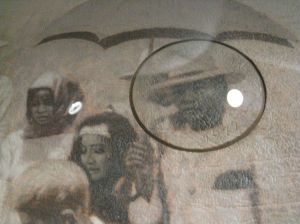


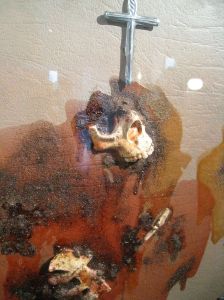
There’s no doubt that Eski is one of the most important artists of our time. I am a big fan of artists having something to say and the skill to say it with his art. Eski is definitely in my top 5 favorites. But I don’t know what to think of the performance except that…to say something positive…Eski is willing to take risks as his non-formulaic paintings prove.
Kindly tell me more about the Igorot Exposition…
For Hans Bulos, if Eski is in your top 5, who are the other 4?
“Igorot Exposition” is a mixed media piece that comments on the experience of Igorots, indigenous Filipinos from the Cordillera Highlands in Northern Philippines. A group of them had been sent to the US for the World’s Fair in St. Louis 1904, when the Philippines was still an American colony. They were subjected to various medical experiments (even opened up) to allow American archeologists to study their insides— similar to the Jewish experience under Nazi Germany. Esquillo fabricates a hospital bed, underneath which he paints the insides of an Igorot as documented in an old photograph. The piece is just 11 inches long.
Here are the ones I like most for their contribution to Philippine art (whatever that means to me), but not necessarily in this order:
Mark Justiniani, Jose Tence Ruiz, Alfredo Esquillo, Raul Lebajo, Charlie Co. Apparently, I favor artists who are not scared to explore art in terms of subject matter or medium. Their works are not or substantially not based on pictures; not that this is an issue in today’s art. Mark, TenceRuiz & Esquillo tackle mostly Philippine issues. TenceRuiz is the most consummate artist of all in the sense that he has done paintings, assemblage, installation art, performance art & digital art. Lebajo, mostly universal (primarily environmental) and personal. Charlie Co paints all three issues: local, global and personal. Lebajo is the oldest among them with a 40year career. I admire him for exploring surrealism (yes, including decapitated bodies to tackle issues during the Cold War) in the absence of a market for it, a shift from abstraction where he already enjoyed both critical acclaim and commercial success, exhibiting yearly at the Luz Gallery and being collected by prominent collectors and even institutions like the Central Bank. Even his still lifes are original, a hard thing to accomplish in itself as the subject matter only exist in his imagination even as they appear to be common objects. Only 4 Pinoy artist found their work in the front cover of Asian Art News: Lebajo, TenceRuiz, Pacita Abad and Onib Olmedo.
I didn’t include Onib Olmedo and Santi Bose because they are dead already nor Danilo Dalena because he is not anymore active in the art scene. I mentioned these 3 in their order of my preference based on skill and body of work.
As to wow factor: 1) Ronald Ventura and 2) Andres Barrioquinto. Visual art should be visual. I don’t know where to put John Santos yet, but he is definitely a must-have. Kudos to him for being able to get out his comfort zone even when there was no need.
As for subject matter:
1) Geraldine Javier, specially of works about death or dying (so peaceful!). Her subject matter is evolving and it seems that there is no limit to where she can go.
2) Kiko Escora, specially about sexual dynamics but not the recent ones at Manila Contemporary which were about the sexual act already (a trend in the US)
3) Jojo Legaspi….mostly all are taboo. I can/will never own them but that doesn’t mean I don’t appreciate them.
4) Manny Garibay, specially those about religion which may offend some people. Garibay is one artist who just loves to paint because he is too good at it. His career is based on pure merit and not on perception management.
As for specific works of art:
1) Nona Garcia’s “See Saw” (winner of Phillip Morris Award) and her huge painting of an abandoned truck with its location. These two are top of my list. Conceptual art at its finest.
2) Elmer Borlongan’s “Gabay” and the big one of Paulino Que
3) Jose Tence Ruiz’s “Dahlings…..Big Hats are Definitely In” and “Bunjeefixion”
4) Raul Lebajo’s “Chili Man”, “The Day when her Dog turned into a Green Pig” and the self portraits with Paulino Que
5) Ronald Ventura’s huge work, “Human Study”. That should be at the Louvre.
And who wouldn’t want to have a`Borlongan, Cabigting or Jumalon? I also don’t think one can be considered a serious collector of Philippine art if he does not have a Nunelucio Alvarado. No one can argue also against the craftsmanship, relevance and body of work of Ben Cabrera, national artist or not. Credit should also be given to Marcel Antonio for his role in the revival of the popularity of figurative contemporary art. His art is as poetic and as well-crafted as Justiniani’s.
For abstracts, Lao Lian Ben & Romulo Olazo. I have to mention Zobel. Although he is of the past, his abstracts are not. For drawings, Lebajo, Escora, Borlongan, Garibay & BenCab. Scuplture: Barredo, Orlina, Julie Lluch & Alonday.
Lastly, if I can steal a Magsaysay-Ho I will frame it in real gold (if I can steal real gold). Maybe, Borlongan is the next Magsaysay- Ho.
That’s it….and sorry if I got carried away with your one line question.
HI! Thank you for your replies.
For Hans Bulos, I truly appreciate your enthusiasm and can only regret that you were not MORE carried away. I am fairly new in the collection of Philippine Arts and had learnt a lot from what you have to say. Do you have any sort of blog that I can follow? Or an email or facebook account so that I may continue to consult you on Philippine Arts?
Hi Ms. Satoshi Kyo:
I don’t have a blog. This site is all you need, I think. It covers maybe 70% of what one must see in the Philippine (actually, Metro Manila) art scene. It seems to be focused though on Makati-based galleries due to proximity of the author’s base, I guess.
Yes, you can email me about art anytime. It’s hansbulos@yahoo.com. Obviously, i love talking about it. We can also connect via facebook but I open my email more often.
Regards,
Hans